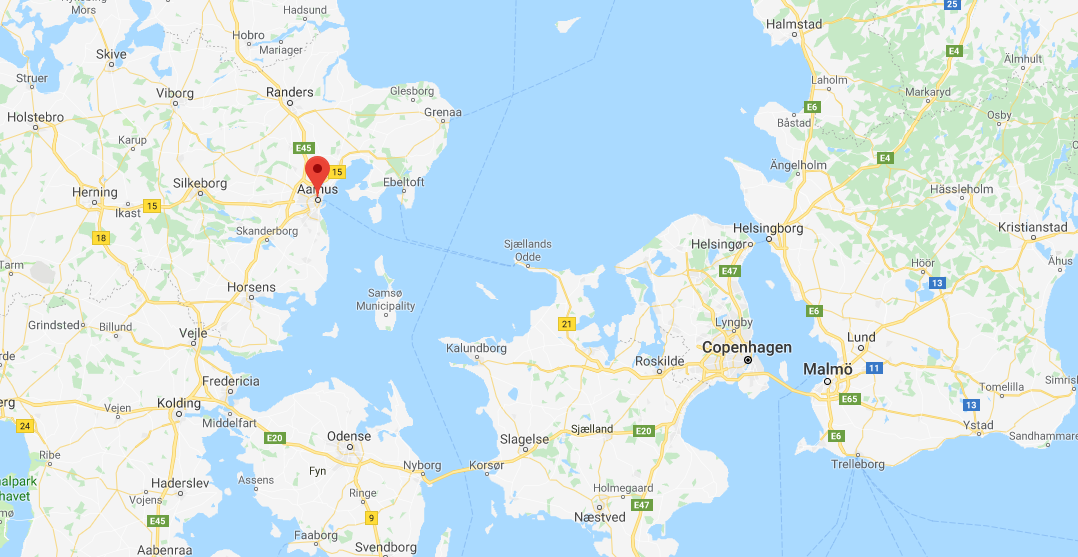Its CEO Peer Heldgaard Kristensen said recently that the city's population has "some of the highest disposable income in Denmark" and that it "spends more money on culture and travel than in other cities and regions". He said the Aarhus catchment area is one which "works for airlines seeking high propensity to travel", adding it is "very sustainable" due to higher than average population growth in the area. And he should know, as until May-2019 he was head of the city's tourist office, VisitAarhus.
MAP - Aarhus is Denmark's second city and a vibrant mix of youthful energy and a blast from the past makes it a city with an energetic beat Source: Google Maps
Source: Google Maps
Aarhus is at the cultural and economic core of the Jutland region and the largest centre for trade, services and industry there. The city ranks as the 92nd largest city in the European Union, and it is also a top 100 conference city in the world. It is the principal industrial port of the country in terms of container handling (50% of the national total) and an important trade hub in the Kattegat Sea.
It is the second city of Denmark, but while it is a much smaller city than Copenhagen (275,000 inhabitants versus 775,000 in the capital) and Copenhagen's metropolitan area is much larger still, Aarhus is the second fastest-growing Danish city.
Major Danish companies have based their headquarters there. The economy is predominantly knowledge- and service-based and is a centre for research and education in the Nordic countries and is home to Aarhus University, Scandinavia's largest university. The fast-paced tech development of Aarhus (the term 'Bluetooth' technology stems from Danish Viking leader King Harald Bluetooth), has delivered a future-proofed city that has delivered many world and European firsts.
The wind power business, which generates most of its revenues from the area, employs about 1,000 people while the biotech industry is well established in the city with many small and medium-sized companies, mainly focused on research and development. Denmark's first research park opened in the city in the 1980s and since developed into the INCUBA Science Park.
The service sector dominates the economy and is growing as the city transitions away from manufacturing. Aarhus is a centre for retail in the Nordic and Baltic countries, with expansive shopping centres, the busiest commercial street in the country and a dense urban core with many speciality shops.
Aarhus is quite aggressive in a number of fields and there is considerable potential for its airport to grow. There are two main drivers. The municipality has more high and middle income jobs, and fewer low income jobs, than the national average. This must influence the propensity to travel outbound. Secondly, local culture, to attract inward visitors. In 2017, Aarhus was European Capital of Culture along with Paphos in Cyprus.
Aarhus airport has two 2.7 kilometre runways. The level of passenger growth had been negative for five of the last eight years but reached +30.6% in 2018 and is currently +11.1% (1H2019). Currently SAS has almost two thirds (63%) of the seat capacity having signed a partnership agreement with the airport and Ryanair holds the remaining 37%. The UK is the main market with almost 40% of seats.
CHART - Aarhus airport has seen mixed fortunes this decade and after traffic declines in the first half it has seen growth in the second Source: CAPA - Centre for Aviation and Aarhus Airport reports
Source: CAPA - Centre for Aviation and Aarhus Airport reports
Last year, the airport handled just over 485,000 passengers and the 500,000 figure should be surpassed in 2019. An aggressive growth strategy is targeting 1.5 million within five years and 2.5 million in 10. The rationale is that the airport has far more potential passengers living close by than any other airport in Jutland.
To do that, viable new routes must be introduced. For summer 2019, SAS began services to Rome and Faro and an intriguing three times weekly service to Manchester, UK, timed for when Premier League football matches are to be played and suspended for the close season (June to August).
The airport is managed by Aarhus Lufthavn A/S. Aarhus City Council has previously stated it is aiming to simplify the airport's ownership structure to attract private investors. And it seems to have succeeded, in the form of JS World Media and Staus A/S, which have invested USD15 million in the development of Aarhus airport in the expectation that over the next ten years the capital injection will amongst other things be translated into increased passenger numbers, route expansion and growth.